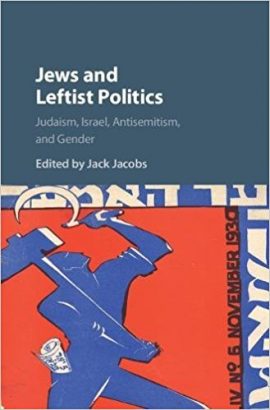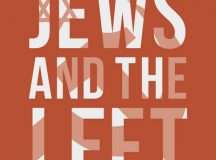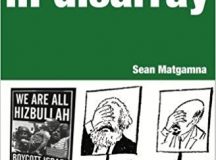This important book is based on an international conference on Jews and the Left held in New York in 2012. As the subtitle denotes, the chapters explore questions of religion, Zionism, anti-Semitism, Marxism and Soviet Communism and contain some remarkable descriptions of the lives of several revolutionary Jewish women.
Jack Jacobs’s introduction opens with a quote from the German sociologist Robert Michels, who in 1911 referred to the abundance of Jews in revolutionary movements. Indeed 18 out of the 29 peoples’ commissars that governed the short-lived Hungarian Soviet in 1919 were Jews. Communist sources estimated that some 35 per cent of the Polish party in the 1930s were Jews. By 1949, it was alleged that half of the members of the US Communist party were Jewish. Yet Michels was no scholarly admirer of Jewish endeavour. He also added that such Jews exhibited:
A sectarian fanaticism which, like an infection, can be communicated to the masses with astonishing frequency; next we have an invincible self-confidence (which in Jewish racial history is most characteristically displayed in the lives of the prophets) … remarkable ambition, an irresistible need to figure in the limelight, and last but not least an almost unlimited power of adaption.
Robert Michels, who as Roberto Michels lived in inter-war Italy and become a follower of Benito Mussolini, personified the pre-Bolshevik stereotyping of the Jewish leftist by the European Right. Even Winston Churchill, known for his philo-semitism, was antagonised by the prominence of ‘the internationalist Jew’.
Jack Jacobs concurs with the appraisal of Isaac Deutscher, the Marxist writer and biographer of Leon Trotsky, that Jewish leftists often ‘dwelt on the borderlines of various civilisations, religions and national cultures’. Anti-Semitism made certain that they remained isolated and were unable to move into mainstream society. Deutscher further suggested that such Jewish marginality in times of revolutionary upheaval propelled these Jews ‘to strike out mentally into wide new horizons’.
Michael Walzer’s keynote address at the conference, presented in this book as The Strangeness of Jewish Leftism, challenged the conventional view that Jews who lean towards the Left do so because of the biblical teachings on social justice of the Jewish Prophets. Walzer points out that the understanding of freedom differs between those Jews who are brought up in orthodox homes and those who grow up in Reform or liberal-left households. Passover, he points out, celebrates a liberation from slavery by God alone – and not by human agency. Yet intervention by concerned citizens in political situations is literally an article of faith by all on the Left.
Emancipation, he argues, by taking most of the Jews out of the realm of rabbinical authority and dictates, opened the way to their political engagement. Walzer provides six examples which challenge the link between perceptions by Jewish leftists and Biblical teachings.
He argues that Jewish leftists are embarrassed by the notion of a chosen people. They prefer to regard themselves as ‘a choosing people’. He comments that ‘yes, we are all chosen, but some of us are more chosen than others’ – and this is pertinent to ‘the subordination of women’ in that only men are favoured to study Torah and considered to be candidates for the rabbinate in the world of Orthodoxy.
Walzer then cites ‘fear and hatred of the goyim – in every age they come to destroy us’. He ridicules right-wing Israelis who parrot this point – as if Zionism has failed, as if Israeli Jews are a persecuted minority. Indeed he further argues that Israel today has realised the plea of the ancient Israelites when they asked Samuel that a king be appointed to rule them – ‘like all the nations’.
Another target for Walzer is the shatdlanim – the ‘court Jews’ who traditionally interceded with the ruling power on behalf of the community. A central goal of Zionism and Jewish leftists was to make the shtadlanim redundant. In the Book of Esther, he reminds us that the ‘maidenly Esther’ was delivered to ‘a heathen king’. Mordechai informed on the conspirators, Bigthana and Teresh, to seek influence for himself and to maintain the security of Ahasuerus’s regime. The leftist Yiddish writer, Y. L. Peretz, labelled Mordechai ‘the first informer and the first pimp’. Clearly not a writer for the religious faint of heart.
Number five on Walzer’s list is the rule of rabbis whom he regards as more creative in the past than the rabbinate today and far better governors than ‘the feudal warriors and absolute monarchs of Christendom’. Yet the congregation was never a democracy and there was no central authority which aided acceptance of statelessness. Finally as the Hatam Sofer implied in the early nineteenth century, any kind of political activity was frowned upon, trust instead should solely be placed in God.
Walzer points out that the oppression of the ghetto produced a sort of welfare state, that Jews were socialists before socialism. Given their persecution, experience and humiliation when times were ripe for revolution, many Jews eagerly embraced it with a boundless enthusiasm.
He concludes with a clarion call that Jewish tradition belongs to all and not to a section of Jewry – a call for more involvement and engagement. Yet clearly it would be possible to draw upon other areas of a multi-layered tradition and demonstrate that the well-spring of Judaism does inform Jewish socialism. Indeed another essayist in this collection, Judith Friedlander, still argues that ‘cultural Jews’ draw upon a Judaic legacy.
Yet there were many Jewish leftists who preferred to forget that they were Jews. Judaism was seen as inferior to the new religion of egalitarian socialism for all humankind. Rosa Luxemburg famously distanced herself from her Jewishness. But as Samuel Farber reflects in another essay such a distancing was tantamount to a withdrawal of solidarity with other Jews, oppressed because of who they were. Deutscher, a Talmudic child prodigy, found salvation in Trotsky in adult life. Farber argues that Deutscher viewed the Jews in polarised terms – as a religious group and as others who coalesced as a unity of left-wing intellectuals who maintained ‘a Jewish style of thought, created and reinforced by their continual social marginality’.
There is a particularly interesting section entitled ‘Gendered Perspectives’ which deals in part with the fate and fortune of revolutionary Jewish women. Barbara Engel describes the sad life of Gesia Gelfman, a member of the group that assassinated Tsar Alexander II in 1881. She was arrested, her death sentence reprieved because of her pregnancy, but almost certainly allowed to die in childbirth. Manya Shochat was involved in the plan to assassinate von Plehve, the Russian minister of the interior, in 1903, but happened to be out of the country when the inevitable arrests took place. Deborah Hertz describes how she became ‘a firebrand activist’ in Palestine instead, a Marxist who participated in the building of the state.
The doyen of Israeli historians, Anita Shapira, has contributed an essay on ‘Socialist Zionism and Nation Building’. She remarks that Berl Katznelson, the socialist Zionist thinker, was always suspicious of real proletarians. He argued that the Jewish proletariat actually favoured the Bund whereas socialist Zionists emerged from the Jewish lower middle class in Eastern Europe. Katznelson was never enamoured by Das Kapital, but believed instead that ‘the character of Zionism was the character of the people realising it’. Shapira argues that if David Ben-Gurion had replaced ‘worker’ in his writings with ‘halutz’ (pioneer), ‘then he would have been essentially correct’.
This is an admirable and diverse set of essays which provides considerable food for thought – a real contribution to an understanding of the relationship between Jews and leftist politics.





































